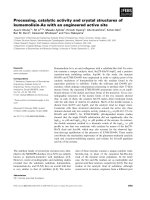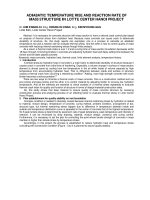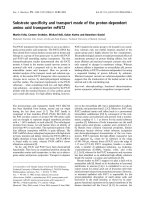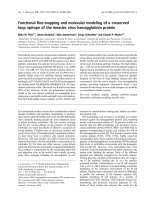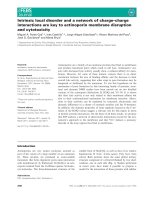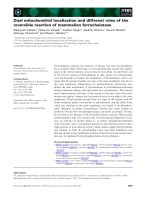Báo cáo khoa học: "PCFGs with Syntactic and Prosodic Indicators of Speech Repairs" potx
Bạn đang xem bản rút gọn của tài liệu. Xem và tải ngay bản đầy đủ của tài liệu tại đây (280.14 KB, 8 trang )
Proceedings of the 21st International Conference on Computational Linguistics and 44th Annual Meeting of the ACL, pages 161–168,
Sydney, July 2006.
c
2006 Association for Computational Linguistics
PCFGs with Syntactic and Prosodic Indicators of Speech Repairs
John Hale
a
Izhak Shafran
b
Lisa Yung
c
Bonnie Dorr
d
Mary Harper
de
Anna Krasnyanskaya
f
Matthew Lease
g
Yang Liu
h
Brian Roark
i
Matthew Snover
d
Robin Stewart
j
a
Michigan State University;
b,c
Johns Hopkins University;
d
University of Maryland, College Park;
e
Purdue University
f
UCLA;
g
Brown University;
h
University of Texas at Dallas;
i
Oregon Health & Sciences University;
j
Williams College
Abstract
A grammatical method of combining two
kinds of speech repair cues is presented.
One cue, prosodic disjuncture, is detected
by a decision tree-based ensemble clas-
sifier that uses acoustic cues to identify
where normal prosody seems to be inter-
rupted (Lickley, 1996). The other cue,
syntactic parallelism, codifies the expec-
tation that repairs continue a syntactic
category that was left unfinished in the
reparandum (Levelt, 1983). The two cues
are combined in a Treebank PCFG whose
states are split using a few simple tree
transformations. Parsing performance on
the Switchboard and Fisher corpora sug-
gests that these two cues help to locate
speech repairs in a synergistic way.
1 Introduction
Speech repairs, as in example (1), are one kind
of disfluent element that complicates any sort
of syntax-sensitive processing of conversational
speech.
(1) and [ the first kind of invasion of ] the first
type of privacy seemed invaded to me
The problem is that the bracketed reparan-
dum region (following the terminology of Shriberg
(1994)) is approximately repeated as the speaker
The authors are very grateful for Eugene Charniak’s help
adapting his parser. We also thank the Center for Language
and Speech processing at Johns Hopkins for hosting the sum-
mer workshop where much of this work was done. This
material is based upon work supported by the National Sci-
ence Foundation (NSF) under Grant No. 0121285. Any opin-
ions, findings andconclusions or recommendations expressed
in this material are those of the authors and do not necessarily
reflect the views of the NSF.
“repairs” what he or she has already uttered.
This extra material renders the entire utterance
ungrammatical—the string would not be gener-
ated by a correct grammar of fluent English. In
particular, attractive tools for natural language
understanding systems, such as Treebank gram-
mars for written corpora, naturally lack appropri-
ate rules for analyzing these constructions.
One possible response to this mismatch be-
tween grammatical resources and the brute facts
of disfluent speech is to make one look more
like the other, for the purpose of parsing. In
this separate-processing approach, reparanda are
located through a variety of acoustic, lexical or
string-based techniques, then excised before sub-
mission to a parser (Stolcke and Shriberg, 1996;
Heeman and Allen, 1999; Spilker et al., 2000;
Johnson and Charniak, 2004). The resulting
parse tree then has the reparandum re-attached in
a standardized way (Charniak and Johnson, 2001).
An alternative strategy, adopted in this paper, is
to use the same grammar to model fluent speech,
disfluent speech, and their interleaving.
Such an integrated approach can use syntac-
tic properties of the reparandum itself. For in-
stance, in example (1) the reparandum is an
unfinished noun phrase, the repair a finished
noun phrase. This sort of phrasal correspon-
dence, while not absolute, is strong in conver-
sational speech, and cannot be exploited on the
separate-processing approach. Section 3 applies
metarules (Weischedel and Sondheimer, 1983;
McKelvie, 1998a; Core and Schubert, 1999) in
recognizing these correspondences using standard
context-free grammars.
At the same time as it defies parsing, con-
versational speech offers the possibility of lever-
aging prosodic cues to speech repairs. Sec-
161
Figure 1: The pause between two or s and the glottalization at the end of the first makes it easy for a
listener to identify the repair.
tion 2 describes a classifier that learns to label
prosodic breaks suggesting upcoming disfluency.
These marks can be propagated up into parse
trees and used in a probabilistic context-free gram-
mar (PCFG) whose states are systematically split
to encode the additional information.
Section 4 reports results on Switchboard (God-
frey et al., 1992) and Fisher EARS RT04F data,
suggesting these two features can bring about in-
dependent improvements in speech repair detec-
tion. Section 5 suggests underlying linguistic and
statistical reasons for these improvements. Sec-
tion 6 compares the proposed grammatical method
to other related work, including state of the art
separate-processing approaches. Section 7 con-
cludes by indicating a way that string- and tree-
based approaches to reparandum identification
could be combined.
2 Prosodic disjuncture
Everyday experience as well as acoustic anal-
ysis suggests that the syntactic interruption in
speech repairs is typically accompanied by a
change in prosody (Nakatani and Hirschberg,
1994; Shriberg, 1994). For instance, the spectro-
gram corresponding to example (2), shown in Fig-
ure 1,
(2) the jehovah’s witness or [ or ] mormons or
someone
reveals a noticeable pause between the occurrence
of the two ors, and an unexpected glottalization at
the end of the first one. Both kinds of cues have
been advanced as explanations for human listen-
ers’ ability to identify the reparandum even before
the repair occurs.
Retaining only the second explanation, Lickley
(1996) proposes that there is no “edit signal” per se
but that repair is cued by the absence of smooth
formant transitions and lack of normal juncture
phenomena.
One way to capture this notion in the syntax
is to enhance the input with a special disjunc-
ture symbol. This symbol can then be propa-
gated in the grammar, as illustrated in Figure 2.
This work uses a suffix ˜+ to encode the percep-
tion of abnormal prosody after a word, along with
phrasal -BRK tags to decorate the path upwards to
reparandum constituents labeled EDITED. Such
NP
NP EDITED CC NP
NP NNP CC−BRK or NNPS
DT NNP POS witness
the jehovah ’s
or~+ mormons
Figure 2: Propagating BRK, the evidence of dis-
fluent juncture, from acoustics to syntax.
disjuncture symbols are identified in the ToBI la-
beling scheme as break indices (Price et al., 1991;
Silverman et al., 1992).
The availability of a corpus annotated with
ToBI labels makes it possible to design a break
index classifier via supervised training. The cor-
pus is a subset of the Switchboard corpus, con-
sisting of sixty-four telephone conversations man-
ually annotated by an experienced linguist accord-
ing to a simplified ToBI labeling scheme (Osten-
dorf et al., 2001). In ToBI, degree of disjuncture
is indicated by integer values from 0 to 4, where
a value of 0 corresponds to clitic and 4 to a major
phrase break. In addition, a suffix p denotes per-
ceptually disfluent events reflecting, for example,
162
hesitation or planning. In conversational speech
the intermediate levels occur infrequently and the
break indices can be broadly categorized into three
groups, namely, 1, 4 and p as in Wong et al.
(2005).
A classifier was developed to predict three
break indices at each word boundary based on
variations in pitch, duration and energy asso-
ciated with word, syllable or sub-syllabic con-
stituents (Shriberg et al., 2005; Sonmez et al.,
1998). To compute these features, phone-level
time-alignments were obtained from an automatic
speech recognition system. The duration of these
phonological constituents were derived from the
ASR alignment, while energy and pitch were com-
puted every 10ms with snack, a public-domain
sound toolkit (Sjlander, 2001). The duration, en-
ergy, and pitch were post-processed according to
stylization procedures outlined in Sonmez et al.
(1998) and normalized to account for variability
across speakers.
Since the input vector can have missing val-
ues such as the absence of pitch during unvoiced
sound, only decision tree based classifiers were
investigated. Decision trees can handle missing
features gracefully. By choosing different com-
binations of splitting and stopping criteria, an
ensemble of decision trees was built using the
publicly-available IND package (Buntine, 1992).
These individual classifiers were then combined
into ensemble-based classifiers.
Several classifiers were investigated for detect-
ing break indices. On ten-fold cross-validation,
a bagging-based classifier (Breiman, 1996) pre-
dicted prosodic breaks with an accuracy of 83.12%
while chance was 67.66%. This compares favor-
ably with the performance of the supervised classi-
fiers on a similar task in Wong et al. (2005). Ran-
dom forests and hidden Markov models provide
marginal improvements at considerable computa-
tional cost (Harper et al., 2005).
For speech repair, the focus is on detecting dis-
fluent breaks. The precision and recall trade-off
on its detection can be adjusted using a thresh-
old on the posterior probability of predicting “p”,
as shown in Figure 3.
In essence, the large number of acoustic and
prosodic features related to disfluency are encoded
via the ToBI label ‘p’, and provided as additional
observations to the PCFG. This is unlike previous
work on incorporating prosodic information (Gre-
0
0.1
0.2
0.3
0.4
0.5
0.6
0 0.1 0.2 0.3 0.4 0.5 0.6
Probability of Miss
Probability of False Alarm
Figure 3: DET curve for detecting disfluent breaks
from acoustics.
gory et al., 2004; Lease et al., 2005; Kahn et al.,
2005) as described further in Section 6.
3 Syntactic parallelism
The other striking property of speech repairs is
their parallel character: subsequent repair regions
‘line up’ with preceding reparandum regions. This
property can be harnessed to better estimate the
length of the reparandum by considering paral-
lelism from the perspective of syntax. For in-
stance, in Figure 4(a) the unfinished reparandum
noun phrase is repaired by another noun phrase –
the syntactic categories are parallel.
3.1 Levelt’s WFR and Conjunction
The idea that the reparandum is syntactically par-
allel to the repair can be traced back to Levelt
(1983). Examining a corpus of Dutch picture de-
scriptions, Levelt proposes a bi-conditional well-
formedness rule for repairs (WFR) that relates the
structure of repairs to the structure of conjunc-
tions. The WFR conceptualizes repairs as the con-
junction of an unfinished reparandum string (α)
with a properly finished repair (γ). Its original
formulation, repeated here, ignores optional inter-
regna like “er” or “I mean.”
Well-formedness rule for repairs (WFR) A re-
pair α γ is well-formed if and only if there
is a string β such that the string αβ and
∗
γ
is well-formed, where β is a completion of
the constituent directly dominating the last
element of α. (and is to be deleted if that
last element is itself a sentence connective)
In other words, the string α is a prefix of a phrase
whose completion, β—if it were present—would
163
render the whole phrase αβ grammatically con-
joinable with the repair γ. In example (1) α is the
string ‘the first kind of invasion of’, γ is ‘the first
type of privacy’ and β is probably the single word
‘privacy.’
This kind of conjoinability typically requires
the syntactic categories of the conjuncts to be the
same (Chomsky, 1957, 36). That is, a rule schema
such as (2) where X is a syntactic category, is pre-
ferred over one where X is not constrained to be
the same on either side of the conjunction.
X → X Conj X (2)
If, as schema (2) suggests, conjunction does fa-
vor like-categories, and, as Levelt suggests, well-
formed repairs are conjoinable with finished ver-
sions of their reparanda, then the syntactic cate-
gories of repairs ought to match the syntactic cat-
egories of (finished versions of) reparanda.
3.2 A WFR for grammars
Levelt’s WFR imposes two requirements on a
grammar
• distinguishing a separate category of ‘unfin-
ished’ phrases
• identifying a syntactic category for reparanda
Both requirements can be met by adapting Tree-
bank grammars to mirror the analysis of McK-
elvie
1
(1998a; 1998b). McKelvie derives phrase
structure rules for speech repairs from fluent rules
by adding a new feature called abort that can
take values true and false. For a given gram-
mar rule of the form
A → BC
a metarule creates other rules of the form
A [abort = Q] →
B [abort = false] C [abort = Q]
where Q is a propositional variable. These rules
say, in effect, that the constituent A is aborted just
in case the last daughter C is aborted. Rules that
don’t involve a constant value for Q ensure that the
same value appears on parents and children. The
1
McKelvie’s metarule approach declaratively expresses
Hindle’s (1983) Stack Editor and Category Copy Editor rules.
This classic work effectively states the WFR as a program for
the Fidditch deterministic parser.
WFR is then implemented by rule schemas such
as (3)
X → X[abort = true] (AFF) X (3)
that permit the optional interregnum AFF to con-
join an unfinished X-phrase (the reparandum) with
a finished X-phrase (the repair) that comes after it.
3.3 A WFR for Treebanks
McKelvie’s formulation of Levelt’s WFR can be
applied to Treebanks by systematically recoding
the annotations to indicate which phrases are un-
finished and to distinguish matching from non-
matching repairs.
3.3.1 Unfinished phrases
Some Treebanks already mark unfinished
phrases. For instance, the Penn Treebank pol-
icy (Marcus et al., 1993; Marcus et al., 1994) is
to annotate the lowest node that is unfinished with
an -UNF tag as in Figure 4(a).
It is straightforward to propagate this mark up-
wards in the tree from wherever it is annotated to
the nearest enclosing EDITED node, just as -BRK
is propagated upwards from disjuncture marks on
individual words. This percolation simulates the
action of McKelvie’s [abort = true]. The re-
sulting PCFG is one in which distributions on
phrase structure rules with ‘missing’ daughters are
segregated from distributions on ‘complete’ rules.
3.4 Reparanda categories
The other key element of Levelt’s WFR is the
idea of conjunction of elements that are in some
sense the same. In the Penn Treebank annota-
tion scheme, reparanda always receive the label
EDITED. This means that the syntactic category
of the reparandum is hidden from any rule which
could favor matching it with that of the repair.
Adding an additional mark on this EDITED node
(a kind of daughter annotation) rectifies the situ-
ation, as depicted in Figure 4(b), which adds the
notation -childNP to a tree in which the unfin-
ished tags have been propagated upwards. This
allows a Treebank PCFG to represent the general-
ization that speech repairs tend to respect syntactic
category.
4 Results
Three kinds of experiments examined the effec-
tiveness of syntactic and prosodic indicators of
164
S
CC EDITED NP
and NP NP
NP PP
DT JJ NN IN NP
the first kind of NP PP−UNF
NN IN
invasion of
DT JJ NN
the first type
(a) The lowest unfinished node is given.
S
CC EDITED−childNP NP
and NP−UNF NP
NP PP−UNF
DT JJ NN IN NP−UNF
the first kind of NP PP−UNF
NN IN
invasion of
DT JJ NN
the first type
(b) -UNF propagated, daughter-annotated Switchboard tree
Figure 4: Input (a) and output (b) of tree transformations.
speech repairs. The first two use the CYK algo-
rithm to find the most likely parse tree on a gram-
mar read-off from example trees annotated as in
Figures 2 and 4. The third experiment measures
the benefit from syntactic indicators alone in Char-
niak’s lexicalized parser (Charniak, 2000). The ta-
bles in subsections 4.1, 4.2, and 4.3 summarize
the accuracy of output parse trees on two mea-
sures. One is the standard Parseval F-measure,
which tracks the precision and recall for all labeled
constituents as compared to a gold-standard parse.
The other measure, EDIT-finding F, restricts con-
sideration to just constituents that are reparanda. It
measures the per-word performance identifying a
word as dominated by EDITED or not. As in pre-
vious studies, reference transcripts were used in all
cases. A check (
√
) indicates an experiment where
prosodic breaks where automatically inferred by
the classifier described in section 2, whereas in the
(×) rows no prosodic information was used.
4.1 CYK on Fisher
Table 1 summarizes the accuracy of a stan-
dard CYK parser on the newly-treebanked
Fisher corpus (LDC2005E15) of phone conver-
sations, collected as part of the DARPA EARS
program. The parser was trained on the entire
Switchboard corpus (ca. 107K utterances) then
tested on the 5368-utterance ‘dev2’ subset of the
Fisher data. This test set was tagged using MX-
POST (Ratnaparkhi, 1996) which was itself trained
on Switchboard. Finally, as described in section 2
these tags were augmented with a special prosodic
break symbol if the decision tree rated the proba-
bility a ToBI ‘p’ symbol higher than the threshold
value of 0.75.
Annotation
Break index
Parseval F
EDIT F
none
× 66.54 22.9
√
66.08 26.1
daughter annotation
× 66.41 29.4
√
65.81 31.6
-UNF propagation
× 67.06 31.5
√
66.45 34.8
both
× 69.21 40.2
√
67.02 40.6
Table 1: Improvement on Fisher, MXPOSTed tags.
The Fisher results in Table 1 show that syntac-
tic and prosodic indicators provide different kinds
of benefits that combine in an additive way. Pre-
sumably because of state-splitting, improvement
in EDIT-finding comes at the cost of a small decre-
ment in overall parsing performance.
4.2 CYK on Switchboard
Table 2 presents the results of similar experi-
ments on the Switchboard corpus following the
165
train/dev/test partition of Charniak and Johnson
(2001). In these experiments, the parser was given
correct part-of-speech tags as input.
Annotation
Break index
Parseval F
EDIT F
none
× 70.92 18.2
√
69.98 22.5
daughter annotation
× 71.13 25.0
√
70.06 25.5
-UNF propagation
× 71.71 31.1
√
70.36 30.0
both
× 71.16 41.7
√
71.05 36.2
Table 2: Improvement on Switchboard, gold tags.
The Switchboard results demonstrate independent
improvement from the syntactic annotations. The
prosodic annotation helps on its own and in com-
bination with the daughter annotation that imple-
ments Levelt’s WFR.
4.3 Lexicalized parser
Finally, Table 3 reports the performance of Char-
niak’s non-reranking, lexicalized parser on the
Switchboard corpus, using the same test/dev/train
partition.
Annotation Parseval F EDIT F
baseline 83.86 57.6
daughter annotation 80.85 67.2
-UNF propagation 81.68 64.7
both 80.16 70.0
flattened EDITED 82.13 64.4
Table 3: Charniak as an improved EDIT-finder.
Since Charniak’s parser does its own tagging,
this experiment did not examine the utility of
prosodic disjuncture marks. However, the com-
bination of daughter annotation and -UNF prop-
agation does lead to a better grammar-based
reparandum-finder than parsers trained on flat-
tened EDITED regions. More broadly, the re-
sults suggest that Levelt’s WFR is synergistic with
the kind of head-to-head lexical dependencies that
Charniak’s parser uses.
5 Discussion
The pattern of improvement in tables 1, 2, and
3 from none or baseline rows where no syntac-
tic parallelism or break index information is used,
to subsequent rows where it is used, suggest why
these techniques work. Unfinished-category an-
notation improves performance by preventing the
grammar of unfinished constituents from being
polluted by the grammar of finished constituents.
Such purification is independent of the fact that
rules with daughters labeled EDITED-childXP
tend to also mention categories labeled XP fur-
ther to the right (or NP and VP, when XP starts
with S). This preference for syntactic parallelism
can be triggered either by externally-suggested
ToBI break indices or grammar rules annotated
with -UNF. The prediction of a disfluent break
could be further improved by POS features and N-
gram language model scores (Spilker et al., 2001;
Liu, 2004).
6 Related Work
There have been relatively few attempts to harness
prosodic cues in parsing. In a spoken language
system for VERBMOBIL task, Batliner and col-
leagues (2001) utilize prosodic cues to dramati-
cally reduce lexical analyses of disfluencies in a
end-to-end real-time system. They tackle speech
repair by a cascade of two stages – identification of
potential interruption points using prosodic cues
with 90% recall and many false alarms, and the
lexical analyses of their neighborhood. Their ap-
proach, however, does not exploit the synergy be-
tween prosodic and syntactic features in speech re-
pair. In Gregory et al. (2004), over 100 real-valued
acoustic and prosodic features were quantized into
a heuristically selected set of discrete symbols,
which were then treated as pseudo-punctuation in
a PCFG, assuming that prosodic cues function like
punctuation. The resulting grammar suffered from
data sparsity and failed to provide any benefits.
Maximum entropy based models have been more
successful in utilizing prosodic cues. For instance,
in Lease et al. (2005), interruption point probabil-
ities, predicted by prosodic classifiers, were quan-
tized and introduced as features into a speech re-
pair model along with a variety of TAG and PCFG
features. Towards a clearer picture of the inter-
action with syntax and prosody, this work uses
ToBI to capture prosodic cues. Such a method is
analogous to Kahn et al. (2005) but in a genera-
tive framework.
The TAG-based model of Johnson and Charniak
(2004) is a separate-processing approach that rep-
166
resents the state of the art in reparandum-finding.
Johnson and Charniak explicitly model the
crossed dependencies between individual words
in the reparandum and repair regions, intersect-
ing this sequence model with a parser-derived lan-
guage model for fluent speech. This second step
improves on Stolcke and Shriberg (1996) and Hee-
man and Allen (1999) and outperforms the specific
grammar-based reparandum-finders tested in sec-
tion 4. However, because of separate-processing
the TAG channel model’s analyses do not reflect
the syntactic structure of the sentence being ana-
lyzed, and thus that particular TAG-based model
cannot make use of properties that depend on the
phrase structure of the reparandum region. This
includes the syntactic category parallelism dis-
cussed in section 3 but also predicate-argument
structure. If edit hypotheses were augmented to
mention particular tree nodes where the reparan-
dum should be attached, such syntactic paral-
lelism constraints could be exploited in the rerank-
ing framework of Johnson et al. (2004).
The approach in section 3 is more closely re-
lated to that of Core and Schubert (1999) who
also use metarules to allow a parser to switch from
speaker to speaker as users interrupt one another.
They describe their metarule facility as a modi-
fication of chart parsing that involves copying of
specific arcs just in case specific conditions arise.
That approach uses a combination of longest-first
heuristics and thresholds rather than a complete
probabilistic model such as a PCFG.
Section 3’s PCFG approach can also be viewed
as a declarative generalization of Roark’s (2004)
EDIT-CHILD function. This function helps an
incremental parser decide upon particular tree-
drawing actions in syntactically-parallel contexts
like speech repairs. Whereas Roark conditions the
expansion of the first constituent of the repair upon
the corresponding first constituent of the reparan-
dum, in the PCFG approach there exists a separate
rule (and thus a separate probability) for each al-
ternative sequence of reparandum constituents.
7 Conclusion
Conventional PCFGs can improve their detection
of speech repairs by incorporating Lickley’s hy-
pothesis about interrupted prosody and by im-
plementing Levelt’s well-formedness rule. These
benefits are additive.
The strengths of these simple tree-based tech-
niques should be combinable with sophisticated
string-based (Johnson and Charniak, 2004; Liu,
2004; Zhang and Weng, 2005) approaches by
applying the methods of Wieling et al. (2005)
for constraining parses by externally-suggested
brackets.
References
L. Breiman. 1996. Bagging predictors. Machine
Learning, 24(2):123–140.
W. Buntine. 1992. Tree classication software. In Tech-
nology 2002: The Third National Technology Trans-
fer Conference and Exposition, Baltimore.
E. Charniak and M. Johnson. 2001. Edit detection
and parsing for transcribed speech. In Proceedings
of the 2nd Meeting of the North American Chap-
ter of the Association for Computational Linguistics,
pages 118–126.
E. Charniak. 2000. A maximum-entropy-inspired
parser. In Proceedings of NAACL-00, pages 132–
139.
N. Chomsky. 1957. Syntactic Structures. Anua Lin-
guarum Series Minor 4, Series Volume 4. Mouton
de Gruyter, The Hague.
M. G. Core and L. K. Schubert. 1999. A syntactic
framework for speech repairs and other disruptions.
In Proceedings of the 37
th
Annual Meeting of the As-
sociation for Computational Linguistics, pages 413–
420.
J. J. Godfrey, E. C. Holliman, and J. McDaniel. 1992.
SWITCHBOARD: Telephone speech corpus for re-
search and development. In Proceedings of ICASSP,
volume I, pages 517–520, San Francisco.
M. Gregory, M. Johnson, and E. Charniak. 2004.
Sentence-internal prosody does not help parsing the
way punctuation does. In Proceedings of North
American Association for Computational Linguis-
tics.
M. Harper, B. Dorr, J. Hale, B. Roark, I. Shafran,
M. Lease, Y. Liu, M. Snover, and L. Yung. 2005.
Parsing and spoken structural event detection. In
2005 Johns Hopkins Summer Workshop Final Re-
port.
P. A. Heeman and J. F. Allen. 1999. Speech repairs,
intonational phrases and discourse markers: model-
ing speakers’ utterances in spoken dialog. Compu-
tational Linguistics, 25(4):527–571.
D. Hindle. 1983. Deterministic parsing of syntactic
non-fluencies. In Proceedings of the ACL.
M. Johnson and E. Charniak. 2004. A TAG-based
noisy channel model of speech repairs. In Proceed-
ings of ACL, pages 33–39.
167
M. Johnson, E. Charniak, and M. Lease. 2004. An im-
proved model for recognizing disfluencies in conver-
sational speech. In Proceedings of Rich Transcrip-
tion Workshop.
J. G. Kahn, M. Lease, E. Charniak, M. Johnson, and
M. Ostendorf. 2005. Effective use of prosody in
parsing conversational speech. In Proceedings of
Human Language Technology Conference and Con-
ference on Empirical Methods in Natural Language
Processing, pages 233–240.
M. Lease, E. Charniak, and M. Johnson. 2005. Pars-
ing and its applications for conversational speech. In
Proceedings of ICASSP.
W. J. M. Levelt. 1983. Monitoring and self-repair in
speech. Cognitive Science, 14:41–104.
R. J. Lickley. 1996. Juncture cues to disfluency. In
Proceedings the International Conference on Speech
and Language Processing.
Y. Liu. 2004. Structural Event Detection for Rich
Transcription of Speech. Ph.D. thesis, Purdue Uni-
versity.
M. Marcus, B. Santorini, and M. A. Marcinkiewicz.
1993. Building a large annotated corpus of En-
glish: The Penn Treebank. Computational Linguis-
tics, 19(2):313–330.
M. Marcus, G. Kim, M. A. Marcinkiewicz, R. MacIn-
tyre, A. Bies, M. Ferguson, K. Katz, and B. Schas-
berger. 1994. The Penn Treebank: Annotating
Predicate Argument Structure. In Proceedings of
the 1994 ARPA Human Language Technology Work-
shop.
D. McKelvie. 1998a. SDP – Spoken Dialog Parser.
ESRC project on Robust Parsing and Part-of-speech
Tagging of Transcribed Speech Corpora, May.
D. McKelvie. 1998b. The syntax of disfluency in spon-
taneous spoken language. ESRC project on Robust
Parsing and Part-of-speech Tagging of Transcribed
Speech Corpora, May.
C. Nakatani and J. Hirschberg. 1994. A corpus-based
study of repair cues in spontaneous speech. Journal
of the Acoustical Society of America, 95(3):1603–
1616, March.
M. Ostendorf, I. Shafran, S. Shattuck-Hufnagel,
L. Carmichael, and W. Byrne. 2001. A prosodically
labelled database of spontaneous speech. In Proc.
ISCA Tutorial and Research Workshop on Prosody
in Speech Recognition and Understanding, pages
119–121.
P. Price, M. Ostendorf, S. Shattuck-Hufnagel, and
C. Fong. 1991. The use of prosody in syntactic
disambiguation. Journal of the Acoustic Society of
America, 90:2956–2970.
A. Ratnaparkhi. 1996. A maximum entropy part-of-
speech tagger. In Proceedings of Empirical Methods
in Natural Language Processing Conference, pages
133–141.
B. Roark. 2004. Robust garden path parsing. Natural
Language Engineering, 10(1):1–24.
E. Shriberg, L. Ferrer, S. Kajarekar, A. Venkataraman,
and A. Stolcke. 2005. Modeling prosodic feature
sequences for speaker recognition. Speech Commu-
nication, 46(3-4):455–472.
E. Shriberg. 1994. Preliminaries to a Theory of Speech
Disfluencies. Ph.D. thesis, UC Berkeley.
H. F. Silverman, M. Beckman, J. Pitrelli, M. Ostendorf,
C. Wightman, P. Price, J. Pierrehumbert, and J. Hir-
shberg. 1992. ToBI: A standard for labeling English
prosody. In Proceedings of ICSLP, volume 2, pages
867–870.
K. Sjlander, 2001. The Snack sound visualization mod-
ule. Royal Institute of Technology in Stockholm.
/>K. Sonmez, E. Shriberg, L. Heck, and M. Weintraub.
1998. Modeling dynamic prosodic variation for
speaker verification. In Proceedings of ICSLP, vol-
ume 7, pages 3189–3192.
J
¨
org Spilker, Martin Klarner, and G
¨
unther G
¨
orz. 2000.
Processing self-corrections in a speech-to-speech
system. In Wolfgang Wahlster, editor, Verbmobil:
Foundations of speech-to-speech translation, pages
131–140. Springer-Verlag, Berlin.
J. Spilker, A. Batliner, and E. N
¨
oth. 2001. How to
repair speech repairs in an end-to-end system. In
R. Lickley and L. Shriberg, editors, Proc. of ISCA
Workshop on Disfluency in Spontaneous Speech,
pages 73–76.
A. Stolcke and E. Shriberg. 1996. Statistical language
modeling for speech disfluencies. In Proceedings
of the IEEE International Conference on Acoustics,
Speech and Signal Processing, pages 405–408, At-
lanta, GA.
R. M. Weischedel and N. K. Sondheimer. 1983.
Meta-rules as a basis for processing ill-formed in-
put. American Journal of Computational Linguis-
tics, 9(3-4):161–177.
M. Wieling, M-J. Nederhof, and G. van Noord. 2005.
Parsing partially bracketed input. Talk presented at
Computational Linguistics in the Netherlands.
D. Wong, M. Ostendorf, and J. G. Kahn. 2005. Us-
ing weakly supervised learning to improve prosody
labeling. Technical Report UWEETR-2005-0003,
University of Washington Electrical Engineering
Dept.
Q. Zhang and F. Weng. 2005. Exploring features for
identifying edited regions in disfluent sentences. In
Proceedings of the Nineth International Workshop
on Parsing Technologies, pages 179–185.
168

